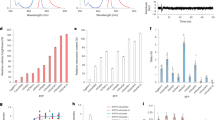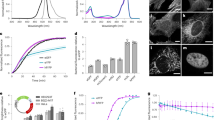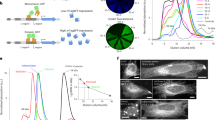Abstract
The red fluorescent protein DsRed has spectral properties that are ideal for dual-color experiments with green fluorescent protein (GFP)1. But wild-type DsRed has several drawbacks, including slow chromophore maturation and poor solubility2,3. To overcome the slow maturation, we used random and directed mutagenesis to create DsRed variants that mature 10–15 times faster than the wild-type protein. An asparagine-to-glutamine substitution at position 42 greatly accelerates the maturation of DsRed, but also increases the level of green emission. Additional amino acid substitutions suppress this green emission while further accelerating the maturation. To enhance the solubility of DsRed, we reduced the net charge near the N terminus of the protein. The optimized DsRed variants yield bright fluorescence even in rapidly growing organisms such as yeast.
This is a preview of subscription content, access via your institution
Access options
Subscribe to this journal
Receive 12 print issues and online access
$209.00 per year
only $17.42 per issue
Buy this article
- Purchase on Springer Link
- Instant access to full article PDF
Prices may be subject to local taxes which are calculated during checkout



Similar content being viewed by others
References
Matz, M.V. et al. Fluorescent proteins from nonbioluminescent Anthozoa species. Nat. Biotechnol. 17, 969–973 (1999).
Baird, G.S., Zacharias, D.A. & Tsien, R.Y. Biochemistry, mutagenesis, and oligomerization of DsRed, a red fluorescent protein from coral. Proc. Natl. Acad. Sci. USA 97, 11984–11989 (2000).
Jakobs, S., Subramaniam, V., Schönle, A., Jovin, T.M. & Hell, S.W. EGFP and DsRed expressing cultures of Escherichia coli imaged by confocal, two-photon and fluorescence lifetime microscopy. FEBS Lett. 479, 131–135 (2000).
Sullivan, K.F. & Kay, S.A. (eds) Green fluorescent proteins. Vol. 58, Methods in Cell Biology. (Academic Press, San Diego, CA; 1999).
Heim, R., Cubitt, A.B. & Tsien, R.Y. Improved green fluorescence. Nature 373, 663–664 (1995).
Cormack, B.P., Valdivia, R.H. & Falkow, S. FACS-optimized mutants of the green fluorescent protein (GFP). Gene 173, 33–38 (1996).
Heim, R. & Tsien, R.Y. Engineering green fluorescent protein for improved brightness, longer wavelengths and fluorescent resonance energy transfer. Curr. Biol. 6, 178–182 (1996).
Miyawaki, A. et al. Fluorescent indicators for Ca2+ based on green fluorescent proteins and calmodulin. Nature 388, 882–887 (1997).
Wall, M.A., Socolich, M. & Ranganathan, R. The structural basis for red fluorescence in the tetrameric GFP homolog DsRed. Nat. Struct. Biol. 7, 1133–1138 (2000).
Yarbrough, D., Wachter, R.M., Kallio, K., Matz, M.V. & Remington, S.J. Refined crystal structure of DsRed, a red fluorescent protein from coral, at 2.0-Å resolution. Proc. Natl. Acad. Sci. USA 98, 462–467 (2001).
Gross, L.A., Baird, G.S., Hoffman, R.C., Baldridge, K.K. & Tsien, R.Y. The structure of the chromophore within DsRed, a red fluorescent protein from coral. Proc. Natl. Acad. Sci. USA 97, 11990–11995 (2000).
Hawley, T.S., Telford, W.G., Ramezani, A. & Hawley, R.G. Four-color flow cytometric detection of retrovirally expressed red, yellow, green, and cyan fluorescent proteins. BioTechniques 30, 1028–1034 (2001).
Living Colors™ DsRed2. CLONTECHniques XVI, 2–3 (2001).
Lauf, U., Lopez, P. & Falk, M.M. Expression of fluorescently tagged connexins: a novel approach to rescue function of oligomeric DsRed-tagged proteins. FEBS Lett. 498, 11–15 (2001).
Wiehler, J., von Hummel, J. & Steipe, B. Mutants of Discosoma red fluorescent protein with a GFP-like chromophore. FEBS Lett. 487, 384–389 (2001).
Terskikh, A. et al. “Fluorescent timer”: protein that changes color with time. Science 290, 1585–1588 (2000).
Cronin, S. & Hampton, R. A genetics-friendly GFP assay. Trends Cell Biol. 9, 36 (1999).
Cadwell, R.C. & Joyce, G.F. Mutagenic PCR. In PCR Primer. A laboratory manual. (eds Dieffenbach, C.W. & Dveksler, G.S.) 583–589 (Cold Spring Harbor Laboratory Press, Cold Spring Harbor, NY; 1995).
Verkhusha, V.V. et al. An enhanced mutant of red fluorescent protein DsRed for double labeling and developmental timer of neural fiber bundle formation. J. Biol. Chem. 276, 29621–29624 (2001).
Rossanese, O.W. et al. A role for actin, Cdc1p and Myo2p in the inheritance of late Golgi elements in Saccharomyces cerevisiae. J. Cell Biol. 153, 47–61 (2001).
Lakowicz, J.R. Principles of fluorescence spectroscopy, Edn. 2. (Kluwer Academic/Plenum Publishers New York, NY; 1999).
Sikorski, R.S. & Hieter, P. A system of shuttle vectors and yeast host strains designed for efficient manipulation of DNA in Saccharomyces cerevisiae. Genetics 122, 19–27 (1989).
Rossanese, O.W. et al. Golgi structure correlates with transitional endoplasmic reticulum organization in Pichia pastoris and Saccharomyces cerevisiae. J. Cell Biol. 145, 69–81 (1999).
Acknowledgements
Thanks to Sergey Lukyanov for sharing unpublished data, to Hiromi Sesaki and Rob Jensen for providing the pCox4-DsRed expression plasmid, to Susan Lindquist for use of the spectrofluorometer, to Dan Strongin for assistance with Supplementary Figure 1A, and to members of the Glick lab for feedback on the manuscript. This work was supported by grants from the National Science Foundation (MCB-9875939) and the American Cancer Society (RPG-00-245-01-CSM).
Author information
Authors and Affiliations
Corresponding author
Supplementary information
Rights and permissions
About this article
Cite this article
Bevis, B., Glick, B. Rapidly maturing variants of the Discosoma red fluorescent protein (DsRed). Nat Biotechnol 20, 83–87 (2002). https://doi.org/10.1038/nbt0102-83
Received:
Accepted:
Issue Date:
DOI: https://doi.org/10.1038/nbt0102-83
This article is cited by
-
Red Fluorescent Protein Variant with a Dual-Peak Emission of Fluorescence
Marine Biotechnology (2023)
-
Selection of red fluorescent protein for genetic labeling of mitochondria and intercellular transfer of viable mitochondria
Scientific Reports (2022)
-
The hAT-family transposable element, hopper, from Bactrocera dorsalis is a functional vector for insect germline transformation
BMC Genetics (2020)
-
Collective cell migration of Dictyostelium without cAMP oscillations at multicellular stages
Communications Biology (2019)
-
Multicolor multiscale brain imaging with chromatic multiphoton serial microscopy
Nature Communications (2019)



